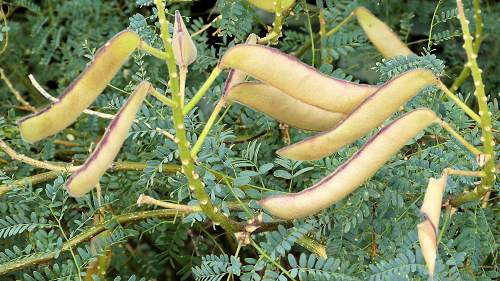Growing Erythrostemon gilliesii:
Bird of Paradise Bush
Description
Form: A shrub with an open, casual appearance.
Leaf retention: Evergreen but cold deciduous.
Growth rate: Rapid.
Mature Size: 6' (1.8m) high and nearly as wide.
Flowers: Yellow flowers in spikes, with 3" (7.6cm) long red stamens.
Bloom: Spring through summer.
Fruit: Slightly curved brown seed pods pop open unexpectedly when ripe, scattering large, flattened bean-like seeds. The pods are ready to open when the seeds inside can be heard rattling freely.
Leaves: Small green acacia-like leaflets.
Stems: No thorns.
Roots: A nitrogen-fixing legume*.
Wildlife: The flowers attract butterflies and hummingbirds.
Toxic / Danger: All parts are poisonous.
Origin: Temperate regions of South America.
Form: A shrub with an open, casual appearance.
Leaf retention: Evergreen but cold deciduous.
Growth rate: Rapid.
Mature Size: 6' (1.8m) high and nearly as wide.
Flowers: Yellow flowers in spikes, with 3" (7.6cm) long red stamens.
Bloom: Spring through summer.
Fruit: Slightly curved brown seed pods pop open unexpectedly when ripe, scattering large, flattened bean-like seeds. The pods are ready to open when the seeds inside can be heard rattling freely.
Leaves: Small green acacia-like leaflets.
Stems: No thorns.
Roots: A nitrogen-fixing legume*.
Wildlife: The flowers attract butterflies and hummingbirds.
Toxic / Danger: All parts are poisonous.
Origin: Temperate regions of South America.
Cultivation and Uses
USDA hardiness zones: 7-11.
Heat tolerant: Yes.
Drought tolerant: Yes.
Sun: Full sun is required to avoid fungal infections during the rainy season.
Soil: Well draining, low organic content, pH 5.6-8.5 (acidic to alkaline). Plant in a hole at least 2' (60cm) deep; shallow rocky soil results in a stunted plant. *Do not use a nitrogen fertilizer.
Water once established: Once or twice a month.
Mulch: Use organic mulch where winter freezes occur, if desired, and keep 8" (21cm) away from stem. Remove mulch after the last freeze.
Prune: Remove dead and damaged stems after the last frost. Flowers bloom on new wood. Old wood can be severely trimmed. After two years, the plant will regrow from its roots if cut to the ground.
Litter: Low.
Propagation: Seed.
Uses: Ornamental.
USDA hardiness zones: 7-11.
Heat tolerant: Yes.
Drought tolerant: Yes.
Sun: Full sun is required to avoid fungal infections during the rainy season.
Soil: Well draining, low organic content, pH 5.6-8.5 (acidic to alkaline). Plant in a hole at least 2' (60cm) deep; shallow rocky soil results in a stunted plant. *Do not use a nitrogen fertilizer.
Water once established: Once or twice a month.
Mulch: Use organic mulch where winter freezes occur, if desired, and keep 8" (21cm) away from stem. Remove mulch after the last freeze.
Prune: Remove dead and damaged stems after the last frost. Flowers bloom on new wood. Old wood can be severely trimmed. After two years, the plant will regrow from its roots if cut to the ground.
Litter: Low.
Propagation: Seed.
Uses: Ornamental.
Comments
This plant is a member of the Legume family (Fabaceae). The scientific synonym of this plant is Caesalpinia gilliesii. Other common names are Bird of Paradise Shrub and Desert Bird of Paradise. Erythrostemon gilliesii is not related to the Bird of Paradise genus Strelitzia of South Africa.
Do you have additional information or a different experience for these plants that you would like to share? Email info@GardenOracle.com. All contributions are welcome and appreciated.
This plant is a member of the Legume family (Fabaceae). The scientific synonym of this plant is Caesalpinia gilliesii. Other common names are Bird of Paradise Shrub and Desert Bird of Paradise. Erythrostemon gilliesii is not related to the Bird of Paradise genus Strelitzia of South Africa.
Do you have additional information or a different experience for these plants that you would like to share? Email info@GardenOracle.com. All contributions are welcome and appreciated.



Latest update: July, 2024
© 2008-2025 by GardenOracle.com

